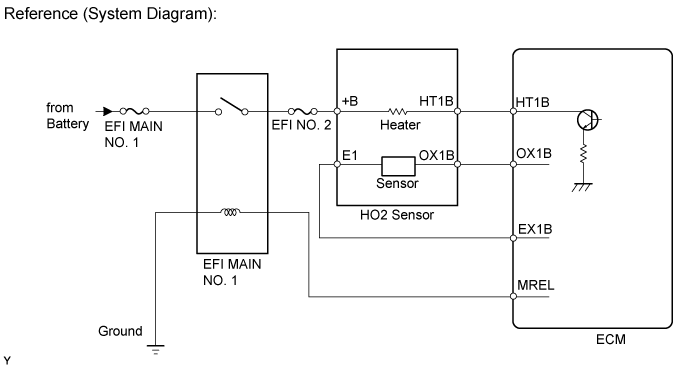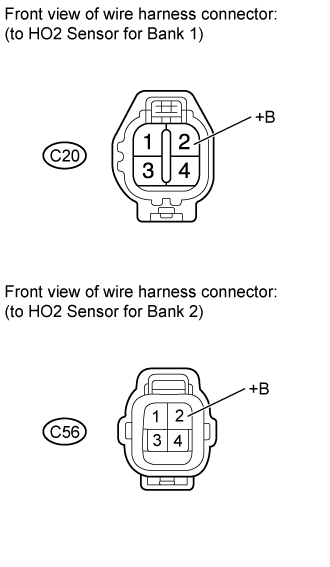Dtc P0037 Oxygen Sensor Heater Control Circuit Low (Bank 1 Sensor 2)
DESCRIPTION
MONITOR DESCRIPTION
WIRING DIAGRAM
CONFIRMATION DRIVING PATTERN
INSPECTION PROCEDURE
INSPECT HEATED OXYGEN SENSOR (HEATER RESISTANCE)
CHECK TERMINAL VOLTAGE (+B OF HO2 SENSOR)
INSPECT NO. 2 INTEGRATION RELAY (EFI MAIN NO. 1)
CHECK HARNESS AND CONNECTOR (HO2 SENSOR - NO. 2 INTEGRATION RELAY)
CHECK HARNESS AND CONNECTOR (HO2 SENSOR - ECM)
CHECK WHETHER DTC OUTPUT RECURS
DTC P0037 Oxygen Sensor Heater Control Circuit Low (Bank 1 Sensor 2) |
DTC P0038 Oxygen Sensor Heater Control Circuit High (Bank 1 Sensor 2) |
DTC P0057 Oxygen Sensor Heater Control Circuit Low (Bank 2 Sensor 2) |
DTC P0058 Oxygen Sensor Heater Control Circuit High (Bank 2 Sensor 2) |
DTC P102D O2 Sensor Heater Circuit Performance Bank 1 Sensor 2 Stuck ON |
DTC P105D O2 Sensor Heater Circuit Performance Bank 2 Sensor 2 Stuck ON |
DESCRIPTION
- Refer to DTC P0137 (Click here).
- HINT:
- When any of these DTCs is stored, the ECM enters fail-safe mode. The ECM turns off the Heated Oxygen (HO2) Sensor heater in fail-safe mode. Fail-safe mode continues until the engine switch is turned off.
- The ECM provides a pulse width modulated control circuit to adjust the current through the heater. The HO2 sensor heater circuit uses a relay on the +B side of the circuit.
DTC Code
| DTC Detection Condition
| Trouble Area
|
P0037
P0057
| The Heated Oxygen (HO2) sensor heater current is below 0.3 A
(1 trip detection logic)
| - Open in Heated Oxygen (HO2) sensor heater circuit
- HO2 sensor heater (for Sensor 2)
- No. 2 integration relay
- ECM
|
P0038
P0058
| The Heated Oxygen (HO2) sensor heater current is higher than 2 A
(1 trip detection logic)
| - Short in HO2 sensor heater circuit
- HO2 sensor heater (for Sensor 2)
- No. 2 integration relay
- ECM
|
P102D
P105D
| The heater current is higher than the specified value while the heater is not operating.
(1 trip detection logic)
| ECM
|
MONITOR DESCRIPTION
The sensing portion of the Heated Oxygen (HO2) sensor has a zirconia element which is used to detect the oxygen concentration in the exhaust gas. If the zirconia element is at the appropriate temperature, and the difference between the oxygen concentrations surrounding the inside and outside surfaces of the sensor is large, the zirconia element generates voltage signals. In order to increase the oxygen concentration detecting capacity of the zirconia element, the ECM supplements the heat from the exhaust with heat from a heating element inside the sensor.- Heated oxygen sensor heater range check (P0037, P0038, P0057, P0058, P102D and P105D):
The ECM monitors the current applied to the heated oxygen sensor heater to check the heater for malfunctions.
If the heater current is outside the normal range, the signal transmitted by the heated oxygen sensor becomes inaccurate. When the current in the heated oxygen sensor heater is outside the normal operating range, the ECM interprets this as a malfunction in the sensor heater and stores a DTC.
WIRING DIAGRAM
Refer to DTC P0137 (Click here).
CONFIRMATION DRIVING PATTERN
These DTCs are stored when the engine idles for 110 seconds or more.
INSPECTION PROCEDURE
- HINT:
- Sensor 2 refers to the sensor mounted behind the Three-Way Catalytic Converter (TWC) and located far from the engine assembly.
- Read freeze frame data using the GTS. Freeze frame data records the engine condition when malfunctions are detected. When troubleshooting, freeze frame data can help determine if the vehicle was moving or stationary, if the engine was warmed up or not, if the air-fuel ratio was lean or rich, and other data from the time the malfunction occurred.
- Bank 1 refers to the bank that includes the No. 1 cylinder*.
*: The No. 1 cylinder is the cylinder which is farthest from the transmission.
- Bank 2 refers to the bank that does not include the No. 1 cylinder.
- Sensor 1 refers to the sensor closest to the engine assembly.
- Sensor 2 refers to the sensor farthest away from the engine assembly.
| 1.INSPECT HEATED OXYGEN SENSOR (HEATER RESISTANCE) |
Disconnect the C20 or C56 heated oxygen (HO2) sensor connector.
Measure the resistance according to the value(s) in the table below.
- Standard Resistance:
Tester Connection
| Condition
| Specified Condition
|
1 (HT1B) - 2 (+B)
| 20°C (68°F)
| 11 to 16 Ω
|
1 (HT1B) - 4 (E1)
| Always
| 10 kΩ or higher
|
1 (HT2B) - 2 (+B)
| 20°C (68°F)
| 11 to 16 Ω
|
1 (HT2B) - 4 (E1)
| Always
| 10 kΩ or higher
|
| 2.CHECK TERMINAL VOLTAGE (+B OF HO2 SENSOR) |
Disconnect the C20 or C56 HO2 sensor connector.
Measure the voltage according to the value(s) in the table below.
- Standard Voltage:
Tester Connection
| Switch Condition
| Specified Condition
|
C20-2 (+B) - Body ground
| Engine switch on (IG)
| 11 to 14 V
|
C56-2 (+B) - Body ground
| Engine switch on (IG)
| 11 to 14 V
|
ResultResult
| Proceed to
|
NG
| A
|
OK
| B
|
| 3.INSPECT NO. 2 INTEGRATION RELAY (EFI MAIN NO. 1) |
Remove the No. 2 integration relay from the engine room relay block.
Inspect the No. 2 integration relay (EFI MAIN NO. 1) (Click here).
| | REPLACE NO. 2 INTEGRATION RELAY (EFI MAIN NO. 1) |
|
|
| 4.CHECK HARNESS AND CONNECTOR (HO2 SENSOR - NO. 2 INTEGRATION RELAY) |
Disconnect the C20 or C56 HO2 sensor connector.
Remove the integration relay from the engine room relay block.
Measure the resistance according to the value(s) in the table below.
- Standard Resistance:
Tester Connection
| Condition
| Specified Condition
|
C20-2 (+B) - 1S-1
| Always
| Below 1 Ω
|
C56-2 (+B) - 1S-1
| Always
| Below 1 Ω
|
C20-2 (+B) or 1S-1 - Body ground
| Always
| 10 kΩ or higher
|
C56-2 (+B) or 1S-1 - Body ground
| Always
| 10 kΩ or higher
|
| | REPAIR OR REPLACE HARNESS OR CONNECTOR |
|
|
| 5.CHECK HARNESS AND CONNECTOR (HO2 SENSOR - ECM) |
Disconnect the C20 or C56 HO2 sensor connector.
Disconnect the C45 ECM connector.
Measure the resistance according to the value(s) in the table below.
- Standard Resistance:
Tester Connection
| Condition
| Specified Condition
|
C20-1 (HT1B) - C45-21 (HT1B)
| Always
| Below 1 Ω
|
C56-1 (HT2B) - C45-44 (HT2B)
| Always
| Below 1 Ω
|
C20-1 (HT1B) or C45-21 (HT1B) - Body ground
| Always
| 10 kΩ or higher
|
C56-1 (HT2B) or C45-44 (HT2B) - Body ground
| Always
| 10 kΩ or higher
|
| | REPAIR OR REPLACE HARNESS OR CONNECTOR |
|
|
| 6.CHECK WHETHER DTC OUTPUT RECURS |
Connect the GTS to the DLC3.
Turn the engine switch on (IG).
Turn the tester on.
Clear DTCs (Click here).
Start the engine.
Allow the engine to idle for 2 minutes or more.
Enter the following menus: Powertrain / Engine and ECT / DTC.
Read DTCs.
ResultResult
| Proceed to
|
No DTC is output
| A
|
P0037, P0038, P0057, P0058, P102D and/or P105D are output
| B
|


